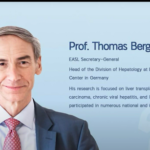Editor’s Note
Liver transplantation is one of the curative treatment options for hepatocellular carcinoma (HCC). However, due to the limited availability of liver donors compared to the number of patients awaiting transplantation, only a small number of HCC patients can receive liver transplantation. Previous studies have shown that local treatment before liver transplantation in HCC patients can effectively prevent tumor progression, increase the transplant rate, and reduce the postoperative recurrence rate. Transarterial chemoembolization (TACE) and ablation techniques such as radiofrequency ablation (RFA), microwave ablation, and percutaneous ethanol injection are the most commonly used bridge therapies before liver transplantation. At the International Liver Transplantation Society (ILTS) annual meeting held in Rotterdam, Netherlands, from May 3 to 6, 2023, Dr. Catherine Lamarque and her colleagues from the Henri Mondor Hospital in France reported on a clinical study (DELTAS-HCC) that showed that liver resection or thermal ablation can be effective bridges to liver transplantation for HCC and do not adversely affect patient outcomes before and after transplantation.
In order to maximize the utility of liver transplantation and prevent premature liver transplantation surgery in clinical practice, French researchers conducted a clinical study in 2015. The study aimed to implement a delayed transplant strategy (DS) for HCC patients awaiting liver transplantation, involving either surgical resection (SR) or thermal ablation (TA) as treatment, and postponing liver transplantation until tumor recurrence. The purpose of this study was to assess the feasibility of the DS strategy to ensure that patients’ prognosis would not be negatively impacted.
The study included French HCC patients with AFP scores ≤2 between 2015 and 2018. After extracting data from the French national liver transplant database, a total of 2,025 patients were ultimately included. Among them, 238 patients (11.7%) with multiple HCC and 74 patients (3.7%) meeting DS criteria but not entering DS were excluded. The remaining 1,713 patients were divided into four groups: single tumor treated with DS (DS, n=341), treated with other local regional therapies without DS (LRT, n=879), HCC patients who could not be treated (did not receive liver transplantation) (UH, n=346), and T1 tumors (T1, n=147). The study compared the pre-transplant dropout rates and 5-year recurrence and survival rates among the four groups of patients.
Clinical characteristics of the patients are shown in Table 1.

The results showed that the pre-transplant dropout rates for the DS, LRT, UH, and T1 groups were 13%, 18%, 21%, and 25%, respectively (P=0.0017, see Figure 1). The DS group significantly reduced dropout rates, while the T1 group showed a significant increase. There were no differences in 5-year post-transplant survival rates and recurrence rates among the groups.

The results of the DELTAS-HCC study suggest that the DS strategy can be considered for approximately 20% of HCC candidates. In patients undergoing the DS strategy, it does not have an adverse effect on outcomes before and after liver transplantation. The DS strategy may offer a solution for organ allocation to patients in more urgent need and a more rational approach to liver transplantation treatment. The higher pre-transplant dropout rates in T1 patients appear to be related to their higher MELD scores (average 13.2).
Reference: Evaluation of a delayed liver transplant strategy for patients listed for hepatocellular carcinoma treated with resection or thermo-ablation as a bridge to LT. DELTAS-HCC study. ILTS 2023 Abstract No. O-091


